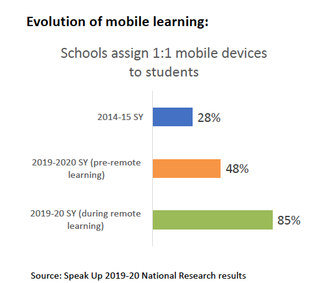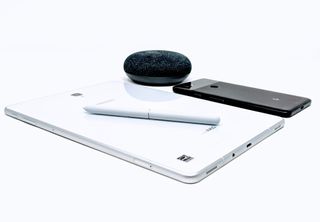“For years, the use of technology for many schools and districts was an add-on, not a fully integrated experience,” says Dr. Julie Evans, CEO of Project Tomorrow, a national education nonprofit organization. “Because of that, teacher preparation programs did not understand the importance of teaching mobile technology integration to preservice teachers.”
A partnership between Project Tomorrow and the University of Kentucky is now focusing on developing a training model for new teachers to learn how to integrate technology within instruction before they reach their own classrooms. In the Mobile Learning Project, preservice teachers are partnered with inservice teachers so they can learn about the practical use of technology in teaching. In exchange, the inservice teachers are exposed to the innovation and creativity that is innate to digital natives.
The backstory for this project emerged over several years of Speak Up data from Project Tomorrow. In the research on the efficacy of mobile devices, they found that principals were concerned about the amount of retraining new teachers required on the integration of technology and that many inservice teachers did not think of mobile devices as a way to impact the quality of student work or change the learning environment.

Challenges of Mobile Technology Integration
The development of the new teacher training model was based on Speak Up data on the challenges of effective mobile learning:
- Only 21% of teachers say they are very comfortable integrating mobile devices into instruction.
- 47% of principals in high poverty communities say teacher integration of technology is their No. 1 challenge.
- 37% of principals say that training preservice teachers to effectively use mobile devices in the classroom should be a top priority.
“The question we grappled with was how to ensure that the next great generation of teachers is well-prepared to leverage the investments that K-12 districts are making around mobile learning,” says Evans.
The big questions they addressed in the partnership with the University of Kentucky teacher preparation program were:
- What are the challenges with helping inservice and preservice teachers develop capacity to use mobile devices and wireless technologies effectively within instruction?
- What are the best methodologies or approaches to helping inservice teachers and preservice teachers develop competency with using mobile devices?
- What are the lessons learned from this project that other schools and districts can apply in their classrooms?
Developing the Mobile Learning Project
The University of Kentucky teacher prep program was always known for innovative thinking, creativity in problem solving, and a willingness to try something different. Project Tomorrow worked with Dr. Lu Young, clinical assistant professor in the Department of Educational Leadership Studies.
Evans and Young determined that peer-to-peer learning would blend the assets and skills preservice teachers could bring to inservice teachers with the assets, skills, and knowledge that inservice teachers could share with preservice teachers to benefit both groups. “The real frontier for professional learning is not having teachers just integrate technology during the school day, but help them leverage or capitalize on the seamless use of technology as the student moves from school to home,” says Young.
“For using devices as instructional tools to create new types of learning experiences, you need teachers who understand their pedagogy, curriculum standards, and their students’ strengths and weaknesses to be effective,” says Evans. “Establishing peer-to-peer learning between preservice and inservice teachers increases the impact and decreases the learning curve once new teachers enter the classroom.”
The team worked with three school districts in Kentucky, each with different issues and challenges. The onset of the pandemic this year accelerated the distribution of devices to students. “Now the challenge is to teach students how to have agency and use the devices in the way they own their own learning and move forward to high levels of efficacy, growth mindset, and intrinsic motivation,” says Young. “Our message at the University of Kentucky Center for Next-Generation Leadership is that we will emerge from the pandemic better than we went in.”
In order to share the results of the program, Project Tomorrow has developed an online course capturing the experiences of the inservice teachers, with the idea that it can be a learning tool for teacher preparation programs.
Who Benefitted from the Project?
Pre-service teachers. College students are better understanding technology implementation and learning how to become classroom teachers.
Practicing teachers. Teachers in classrooms are learning how to use mobile devices beyond student engagement.
School and district administrators. Leaders are now seeing a higher ROI from the implementation of mobile devices within learning.
Program funders or developers. They now receive input as to how to leverage devices effectively to have a greater impact.
Students. Students are benefitting from more informed teachers today and tomorrow.
“From a leadership perspective, we’ve learned that you really have to spend the right amount of time on the front end, talking about the ‘why,’” says Young. “Our faculty is now embedding the lessons we’ve learned during this project into our teacher preparation program so that our students have a good grounding in why mobile technology integration is important in 2020 and beyond so that all students can be successful.”

